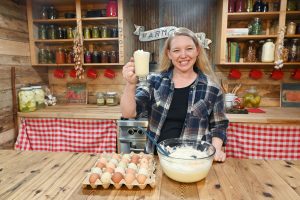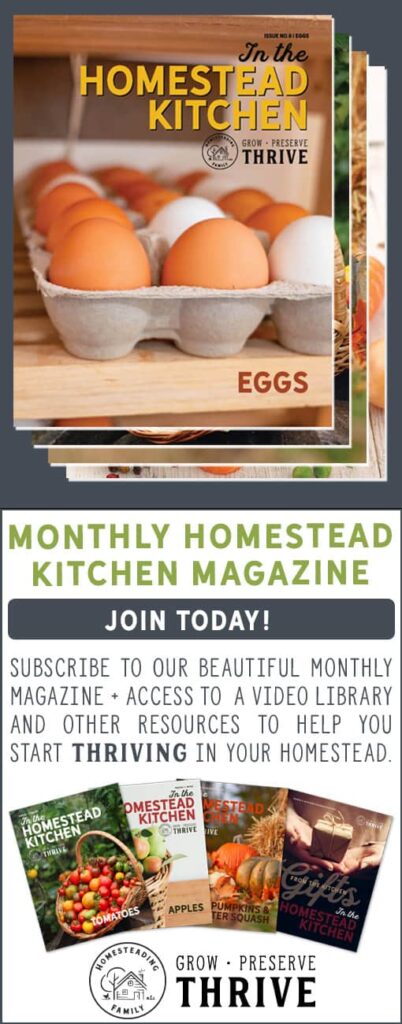For many years we went without a good farm watering system, but we’ve made some upgrades this year that I’d like to share with you!

I’ve previously shared about our barn management system and the micro-watering system that we use in the garden. This post (and video) will focus more on how we get water out to our pastures and our animals.
Before You Implement Your Water Systems
Before I get into sharing about our watering systems, there are a couple of key questions that are important to consider when it comes to water on the homestead.
- Where will you get your water?
- How will you collect your water?
- How will you get your water where it needs to go?
Where Do You Get Your Water?
We all need water on our property. If you’re building a homestead from scratch, updating your existing systems, or planning for the future, this is an important question to answer before implementing any systems.
Where will your water come from?
- Municipal Source
- Rainwater collection
- Well Water
- Natural Spring
- River or Pond
If you are looking to build resiliency and less dependence on “grid systems,” then you should consider collection systems to augment or replace your municipal or even well water source. That is collecting rainwater either into tanks, ponds or both.

Water Storage Systems
Storage systems are extremely important. No matter your system, you need a way to collect and store that water. This is especially important if you’re in a dry area with little rainfall.
Get creative with how you collect and store water. For instance, did you know that for every square foot of roof space, you can collect about 2/3 gallon of water for every inch of rain?
If you have 1,000 sq ft of roof you can catch about 625 gallons of water with one inch of rainfall. That’s a lot of free water!
We have a system here at Riverbend that’s been here for 70 years. We’ve tried to improve it as best as possible without disrupting our wetland area. But with 12 people in the house, the previous system just doesn’t accommodate our large family.

We’ve since implemented an underground catchment system. Since we deal with cold temperatures, it had to be underground so our water wouldn’t freeze. But if you live where it doesn’t freeze, you can do this above ground.
We also have a backup gravity-fed system that will allow us to get water to the house and animals if our power goes out. Creating redundancy in our systems is key (see more on creating redundancy below).

Watering Systems for Pastures
Polypipe
The black Polypipe watering system you see in the video is something I wish I would have done many years ago.
Polypipe comes in rolls from 3/4 of an inch up to 3 inches in diameter. It’s made to be outdoors, and you can either bury it or run it above ground as we have ours now.
I have our Polypipe hooked up to gravity feed for when we don’t need a lot of volume, like just putting water into the troughs. But I like redundancy in our systems, and often we need more flow, so I also currently have a hose providing water from our pressure system. This is all above ground.
After a few years, when I know I like the way everything is working, we will create more permanency in the system by burying the lines and making a permanent connection to our pressure system.

Protection
Though Polypipe is extremely tough, if you’re running it above ground, it’s important to take a few precautions. You’ve made a large investment, and no one wants to see that investment broken when it could have been prevented.
Since I’m not ready to bury the line permanently, I like to have a wide board tucked right beside the pipe where vehicles will be driving over it. This eliminates excess pressure from the tires driving over it multiple times per week.
I ran all of the pipes tight up against the fence to prevent larger animals from stepping on it as well.
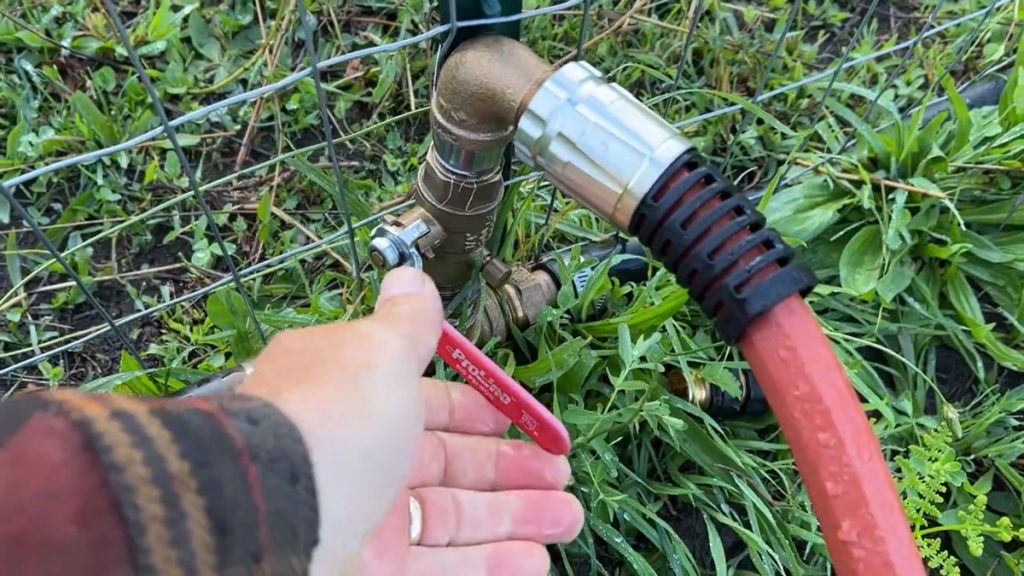
Fittings & Splitters
Once the hose was laid, I created valve systems as frequently as we needed to along the pipe to get the hose wherever we needed it. I put our valves every 180 feet so a 100-foot hose at each valve would give access everywhere along that line and about 100 feet out from the line.
I also ran those valves up, that is vertically, so that they are less likely to get stepped on.
Because we get freezes, we’ve chosen to use brass fittings. They’re a more expensive option, but they handle the unexpected freezes much better.
You can go with plastic Poly fittings that are less expensive if you’re not in a zone that freezes. The next step up from plastic would be a galvanized fitting.
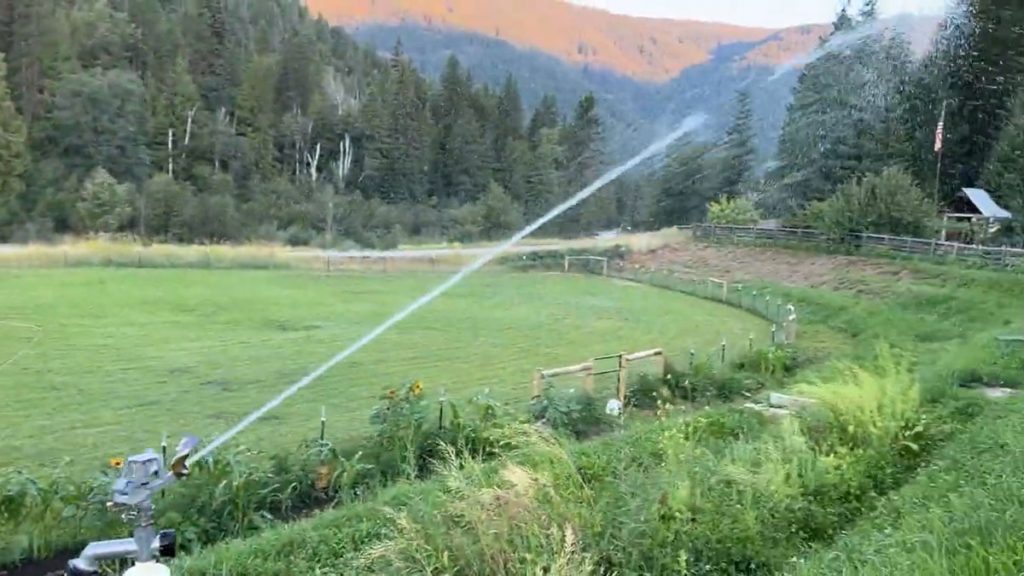
Remember, though, that this is not a year-round system for us. Because we do get freezing temps nearly six months out of the year, we have to drain this system once freezes start to occur regularly.
Those hoses will be fine as we move the animals towards the barn when the winter weather starts to arrive and we have a permanent buried system there with freeze-proof risers.

Running Sprinklers
I’ve been working to improve our pasture here at Riverbend.
After spending time with Joel Salatin, I implemented a sprinkler system that I can utilize during our dry summers to help keep our pastures well-watered.
I set up a sprinkler system from Big Sprinkler that includes a gas-powered pump to get water to our pastures. Ours is the Big Sprinkler 1500H, and it’s been working great. This pumps water from the pond, instead of our spring system, for household and garden use, as we have much more water there in reserve.
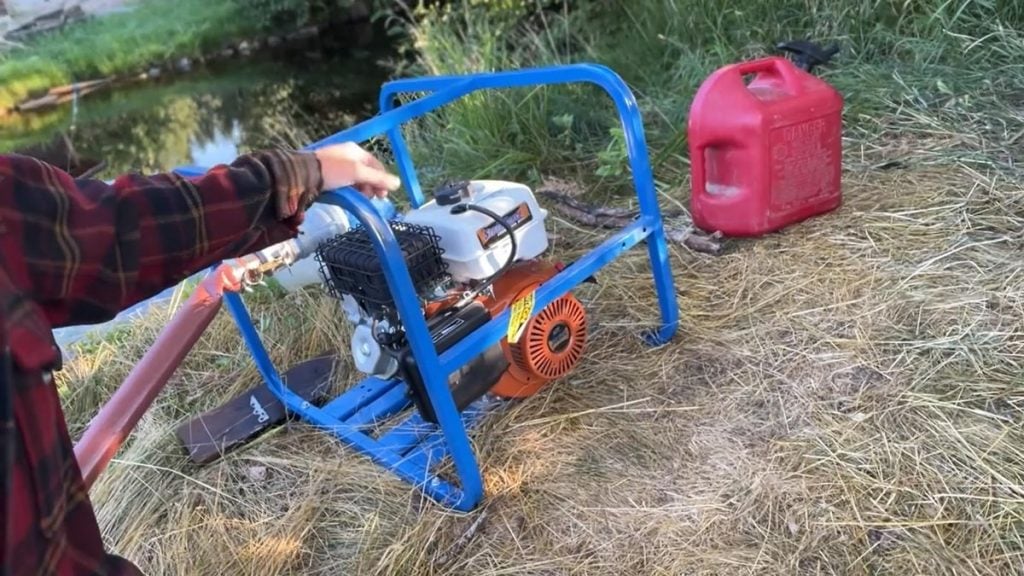
The one thing I’m not pleased with is the gas-powered pump that came in the package we purchased. The pump itself works great, but it’s extremely loud.
I like to do most of our watering during the night or early morning as there is less evaporation and moisture loss due to wind and breezes. However, the noise of this pump makes it impossible to sleep through since it is close to the house, so I have to keep the watering to early-mid morning and early-late evening.
Eventually, I will be looking for a quieter electric pump that I can run at night or very early in the morning.

Watering Systems in the Barn
Many of you have asked how I get water for our animals in winter. My answer to this is having freeze-proof bibs.
The pipes go down about three feet into the ground, below the frost line, to keep from freezing. When you turn them on, they bring the water up and out of the faucet, just like a normal pipe.
But when you turn the faucet off, the water drains from the spigot down about three feet or so. This means the water won’t freeze in the pipe causing all kinds of damage.
Using multiple hoses and frost-free bibs saves a large portion of time and energy when getting water to the animals during the colder months.

Other Watering Options
Submersible & Floating Water Heaters
Since we still have hanging waterers for our chickens and troughs in the barn stalls, we have to keep this water from freezing.
Our go-to is to use a submersible or floating heater. If you don’t have heaters, you may have to break up the ice each day to make sure your animals can get to their water.
It’s small investments like these heaters that add up to huge time and energy savers. They’re often worth every penny of investment.
Redundancy creates resiliency!
My best advice when setting up watering systems is to go slow!
Don’t make your systems permanent until you know they will work for you. When you can take time to think about your systems, apply them, then make adjustments as needed before getting those systems permanent, that’s best.

Making Do vs. Saving Money
You may think systems like what I have described above are expensive. And you are right, sort of.
They can have a significant cost and we have certainly had many years that we had to “make do.” In looking back though, I see I was always spending money somewhere to improve our homestead and I wish I would have prioritized these watering systems sooner.
Water is essential and very heavy to move around. All the years of “making do” in this area has been a lot of hard work and frustration at times. With what I know now, I would prioritize an efficient water system over most other areas on the farm… as far as exterior homestead systems go. I would have saved money and frustration if I had!

More Posts You May Enjoy
- Your Guide on How to Store Water Long Term (Safely)
- Good Enough is Perfect
- 2022 Homesteading Family’s Year In Review
- How to Take a Vacation From the Homestead
- Traditional Skills Summit
- How to Reduce Weeds in the Garden
- My Favorite Tools for Gardening (And How to Care for Garden Tools)
- Spring Garden Planning Tips & Tricks
- How to Build a DIY Hoop House (Greenhouse)
- 12 Things You Must do to Prep the Garden for Winter
- Using Medicinal Herbs on Farm Animals



